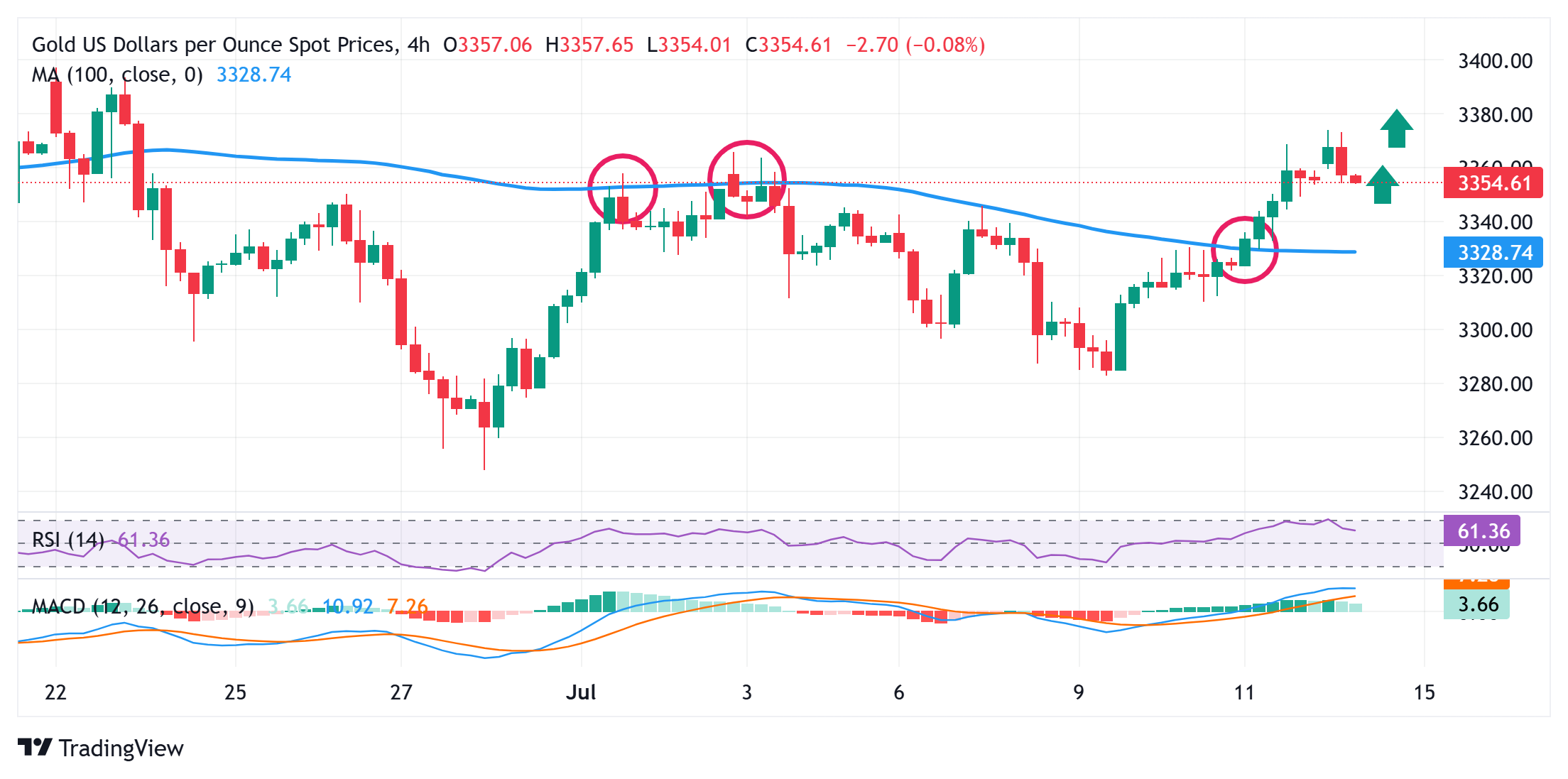- Gold price eases from a multi-week top, though the downside potential seems limited.
- Reduced Fed rate cut bets underpin the USD and act as a headwind for the commodity.
- Rising trade tensions should limit any further losses for the safe-haven precious metal.
Gold price (XAU/USD) remains on the defensive below a three-week high touched during the Asian session this Monday, albeit it lacks follow-through selling. Diminishing odds for an immediate interest rate cut by the Federal Reserve (Fed) assist the US Dollar (USD) to hold steady near its highest level since June 25 and turn out to be a key factor acting as a headwind for the non-yielding yellow metal. However, the downbeat market mood offers some to the safe-haven precious metal.
The already weaker global risk sentiment took another hit from US President Donald Trump’s fresh threat to impose 30% levies on products coming from the European Union (EU) and Mexico from August 1. This marks a further escalation of trade wars and helps limit the downside for the Gold price. Traders also seem reluctant and opt to wait for the release of the latest US inflation figures for cues about the Fed’s rate-cut path before positioning for the next leg of a directional move.
Daily Digest Market Movers: Gold price traders seem non-committed amid mixed fundamental cues
- The already weaker global risk sentiment takes another hit in reaction to US President Donald Trump’s fresh tariff threats on two of the biggest trade partners – Mexico and the European Union. Trump informed European Commission President Ursula von der Leyen and Mexico’s President Claudia Sheinbaum in separate letters on Saturday, adding to a string of over 20 similar tariff notices issued since last Monday.
- The latest development tempers investors’ appetite for riskier assets, which is evident from a generally weaker tone around the equity markets and might continue to act as a tailwind for the safe-haven Gold price. However, confusing signals over the Federal Reserve’s near-term rate-cut path hold back the XAU/USD bulls from placing aggressive bets or building on the recent move up to a multi-week top.
- Minutes from the June 17-18 FOMC meeting showed that most policymakers remain worried about the risk of rising inflation on the back of Trump’s aggressive trade policies and a still resilient US labor market. Moreover, only a couple of officials felt interest rates could be reduced as soon as this month. This assists the US Dollar to hold steady near a multi-week high and caps the non-yielding yellow metal.
- Investors now look to the release of the latest US consumer inflation figures for June on Tuesday, which will be followed by the US Producer Price Index (PPI) on Wednesday. The crucial data, along with speeches from influential FOMC members, would offer more cues about the Fed’s policy outlook, amid bets for over 50 basis points worth of easing by December. This, in turn, will drive the USD demand.
- In the meantime, persistent uncertainty surrounding the implementation of Trump’s erratic trade policies and their impact on the global economy should continue to benefit the traditional safe-haven precious metal.
Gold price bulls might aim towards reclaiming the $3,400 mark while above 100-period SMA on H4

From a technical perspective, last week’s sustained breakout through the 100-period Simple Moving Average (SMA) on the 4-hour chart and a subsequent move beyond the $3,358-3,360 supply zone was seen as a key trigger for the XAU/USD bulls. This, along with positive oscillators on hourly/daily charts, suggests that the path of least resistance for the Gold price is to the upside. Hence, some follow-through strength, towards reclaiming the $3,400 round-figure mark, looks like a distinct possibility.
On the flip side, the $3,240 horizontal zone now seems to protect the immediate downside and any further slide could be seen as a buying opportunity near the $3,326 region. This should help limit the downside for the Gold price near the $3,300 round figure. This is followed by the $3,283-3,282 region, or over a one-week low touched last Tuesday, which, if broken decisively, would make the XAU/USD pair vulnerable to a further acceleration of the fall towards the July swing low, around the $3,248-3,247 area.
Tariffs FAQs
Tariffs are customs duties levied on certain merchandise imports or a category of products. Tariffs are designed to help local producers and manufacturers be more competitive in the market by providing a price advantage over similar goods that can be imported. Tariffs are widely used as tools of protectionism, along with trade barriers and import quotas.
Although tariffs and taxes both generate government revenue to fund public goods and services, they have several distinctions. Tariffs are prepaid at the port of entry, while taxes are paid at the time of purchase. Taxes are imposed on individual taxpayers and businesses, while tariffs are paid by importers.
There are two schools of thought among economists regarding the usage of tariffs. While some argue that tariffs are necessary to protect domestic industries and address trade imbalances, others see them as a harmful tool that could potentially drive prices higher over the long term and lead to a damaging trade war by encouraging tit-for-tat tariffs.
During the run-up to the presidential election in November 2024, Donald Trump made it clear that he intends to use tariffs to support the US economy and American producers. In 2024, Mexico, China and Canada accounted for 42% of total US imports. In this period, Mexico stood out as the top exporter with $466.6 billion, according to the US Census Bureau. Hence, Trump wants to focus on these three nations when imposing tariffs. He also plans to use the revenue generated through tariffs to lower personal income taxes.

